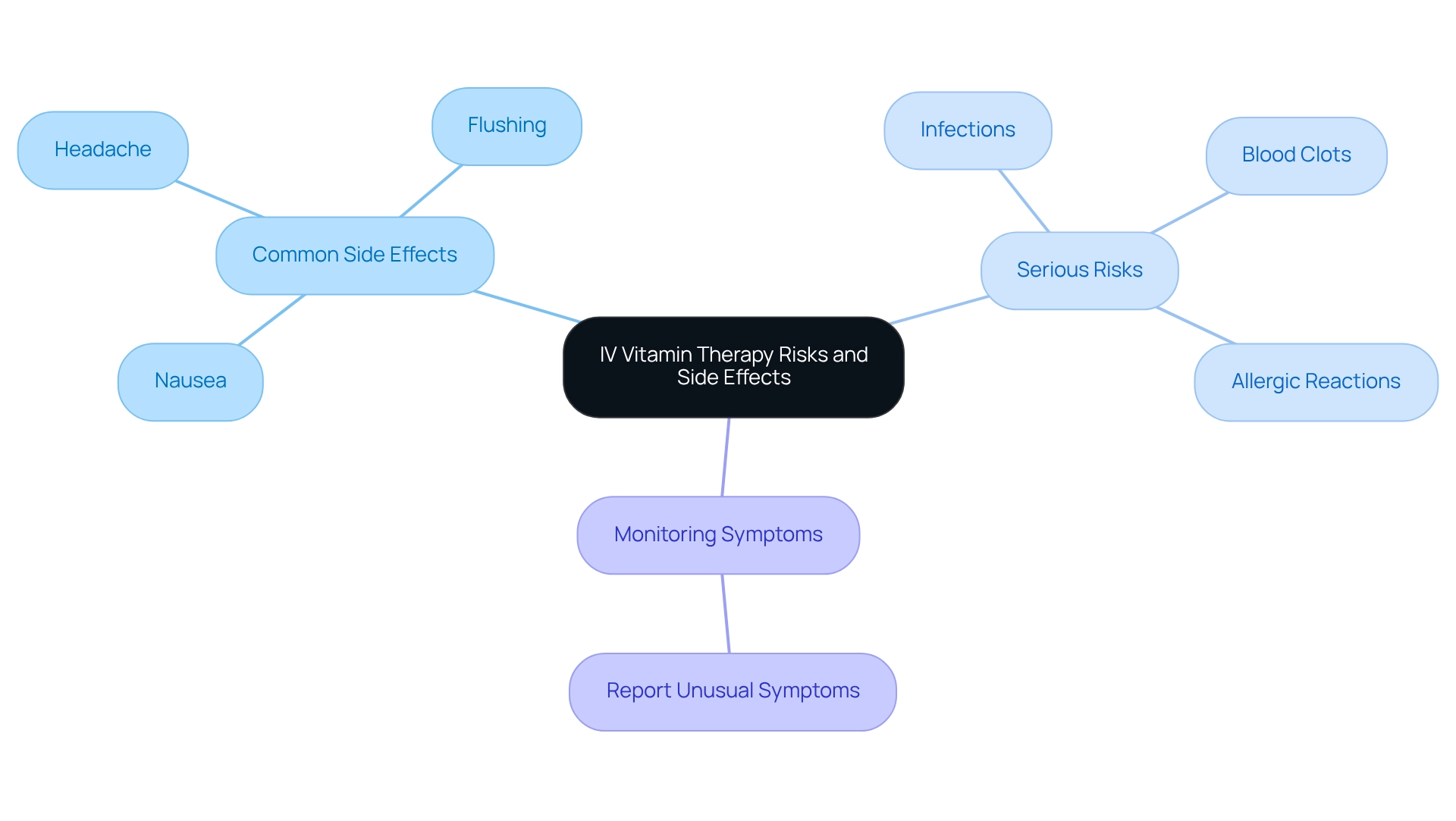Are IV Vitamins Safe? Key Considerations for Your Health
Overview
IV vitamin therapy presents potential safety concerns that warrant careful consideration.
Complications such as infections and allergic reactions can arise, alongside the necessity for professional administration. Therefore, it is crucial to consult healthcare providers before proceeding.
Evaluating personal health conditions is essential, as is considering alternative nutrient delivery methods. This approach ensures that the benefits of IV treatment outweigh the associated risks.
Introduction
In recent years, IV vitamin therapy has surged in popularity as a trendy wellness solution, promising to deliver essential nutrients directly into the bloodstream for enhanced energy and immunity. However, beneath this allure lies a complex landscape of benefits, risks, and safety concerns that warrant careful consideration. From high-profile incidents highlighting potential dangers to the mixed results of clinical research, individuals must navigate a myriad of factors before embracing this treatment.
As the demand for personalized healthcare grows, understanding the implications of IV therapy becomes crucial. It prompts a closer look at its effectiveness, safety measures, and the importance of consulting healthcare professionals before diving in. What should you consider before opting for this therapy? This article aims to explore these essential aspects, ensuring you are well-informed on the topic.
Define IV Vitamin Therapy and Its Purpose
IV nutrient administration is a technique for delivering essential substances directly into the bloodstream via an intravenous drip. This approach is designed to enhance nutrient absorption and is often promoted for its potential to boost energy levels, strengthen immunity, and improve overall wellness. By circumventing the digestive system, IV treatment aims to ensure that nutrients reach the body’s cells more effectively, potentially resulting in faster and more noticeable effects.
Research into the effectiveness of IV nutrient infusion has yielded mixed results. While some clinical trials suggest benefits in energy enhancement and immune support, it is essential to critically evaluate these findings. A significant case involved supermodel Kendall Jenner, who had a severe reaction to a Myers’ cocktail IV drip in 2018. This incident highlights the safety issues linked to IV nutrient administration and raises concerns about whether IV vitamins are safe, stressing the importance of thorough evaluation of possible hazards alongside the asserted advantages. Furthermore, a major concern is whether IV vitamins are safe for nutrient administration. Patients may face complications such as pain, bruising, or infection at the injection site. Older individuals, in particular, may encounter challenges with IV placement due to smaller veins, complicating the procedure further. As Dr. Sam Torbati, cochair of the Department of Emergency Medicine at Cedars-Sinai Medical Center, points out, alternatives like oral supplements can often provide similar benefits at a fraction of the cost. Thus, it is essential to assess the possible benefits against the dangers and take individual wellness needs into account when investigating IV nutrient therapy.
Conversely, facilities such as Hope for Healing Functional Medicine Clinic emphasize comprehending the underlying factors of sickness and rejuvenating well-being through customized care. Their method highlights teamwork with patients to tackle specific medical issues, which may offer a safer and more efficient substitute to IV nutrient administration for certain individuals. This highlights the importance of personalized care in addressing health issues and enhancing overall well-being.
Assess Safety Measures for IV Vitamin Therapy
- Verify Provider Credentials: Ensuring that IV nutrient treatment is administered by licensed healthcare professionals is essential. This guarantees that the treatment is conducted by individuals with the necessary training and expertise. It is crucial to consult a healthcare provider before attempting IV vitamin treatment to determine if IV vitamins are safe for ensuring safety and effectiveness.
- Check Facility Standards: Confirm that the clinic adheres to stringent hygiene and safety protocols. This includes using sterile equipment and maintaining a clean environment to minimize the risk of infection. Notably, IV treatment may promote better cardiovascular health by relaxing blood vessels and regulating blood pressure, making adherence to facility standards even more critical.
- Review Patient Monitoring: It’s vital to ensure that the provider actively monitors vital signs and patient reactions throughout the infusion process. Continuous observation is essential for promptly identifying any adverse effects. A case study on IV hydration emphasizes the significance of providing treatments in a sterile setting by qualified experts, underscoring the necessity for careful monitoring.
- Understand Emergency Procedures: Familiarizing yourself with the clinic’s emergency protocols is important. Knowing how the facility responds to potential complications can provide peace of mind and ensure swift action if needed. Understanding these emergency protocols is essential for guaranteeing patient safety during IV nutrient treatment, particularly when considering if IV vitamins are safe, as highlighted in external sources. Remember, “IV Therapy Promotes Better Cardiovascular Health,” emphasizing the importance of these safety measures.

Identify Risks and Side Effects of IV Vitamin Therapy
- List Common Side Effects: Possible side effects of IV nutrient treatment can include nausea, headache, and flushing. These symptoms may occur as the body adapts to the swift influx of nutrients directly into the bloodstream, which happens more rapidly than with oral supplements.
- Recognize Serious Risks: Significant risks linked to IV nutrient administration include infections, blood clots, and allergic reactions. Such complications can occur, particularly if the procedure is not performed by a qualified provider. As Bobby Stephenson observes, fewer risks arise with a trustworthy provider, highlighting the significance of selecting the appropriate expert for these procedures.
- Monitor for Symptoms: After receiving IV treatment, it is vital to watch for any unusual symptoms. Promptly reporting these to a healthcare provider can help mitigate potential complications and ensure a safe recovery. Consulting credible literature is essential for understanding if IV vitamins are safe, as it helps examine documented side effects and complications linked to IV nutrient therapy. For instance, studies have shown that IV treatment can significantly enhance hydration for individuals experiencing long-term effects of COVID-19, addressing dehydration and alleviating symptoms such as fatigue and weakness. However, the overall consensus among experts is to prioritize nutrition through the digestive system whenever possible, reserving IV treatments for specific medical needs.

Evaluate Personal Health Conditions and Consult Professionals
Assessing individual wellness statuses is essential before considering IV nutrient treatment. It’s important to take into account any pre-existing conditions, such as kidney disease, heart issues, or allergies, which may contraindicate the use of IV treatments. Research indicates that approximately 10% of individuals with chronic kidney disease may question whether IV vitamins are safe due to potential adverse effects from the treatment. Engaging with medical professionals is crucial; discussing your medical history with a qualified expert can help identify any risks associated with the procedure.
A comprehensive nutritional evaluation, including a micronutrient assessment, provides insights into whether IV treatment is necessary for your specific needs. This step is vital, as it allows for a tailored approach to health that considers individual circumstances.
Additionally, exploring alternative methods of nutrient delivery, such as oral supplements or dietary adjustments, may present safer or more effective solutions. With the IV hydration treatment market projected to reach USD 4.23 billion by 2030, understanding the implications of this intervention is increasingly important, particularly as interest in IV procedures grows.
Expert opinions underscore the need for caution; Dr. Joshua Septimus emphasizes that IV treatment is a medical procedure, raising questions about its necessity for healthy individuals compared to maintaining hydration through diet and water intake. Furthermore, case studies focusing on COVID long haulers illustrate the benefits of IV therapy in specific contexts, particularly for addressing dehydration. These cases highlight the importance of assessing personal health conditions, as they necessitate professional consultation before treatment. However, these benefits must be weighed against potential risks, making professional consultation a critical step in the decision-making process regarding whether IV vitamins are safe.
Conclusion
IV vitamin therapy presents a promising yet complex option for those seeking enhanced wellness through direct nutrient delivery. It offers potential benefits, including improved energy levels and immune support. However, the mixed results from clinical research highlight the necessity for a critical evaluation of its effectiveness. Safety concerns, illustrated by notable incidents and the possibility of serious side effects, underscore the importance of proceeding with caution.
Before considering IV therapy, it is essential to assess personal health conditions and consult with qualified healthcare professionals. Understanding individual health needs and potential risks can guide informed decisions regarding this treatment. Furthermore, exploring alternative methods, such as oral supplements, may provide safer and more effective solutions without the complications associated with intravenous administration.
In conclusion, as the popularity of IV vitamin therapy continues to rise, a thorough understanding of its implications is crucial. Prioritizing safety, personal health assessments, and professional guidance will ensure that individuals can make well-informed choices about their wellness journey. Ultimately, the path to optimal health should always be approached with careful consideration and a focus on personalized care.
Frequently Asked Questions
What is IV nutrient administration?
IV nutrient administration is a technique for delivering essential substances directly into the bloodstream via an intravenous drip, designed to enhance nutrient absorption and potentially boost energy levels, strengthen immunity, and improve overall wellness.
How does IV nutrient administration work?
This approach circumvents the digestive system, allowing nutrients to reach the body’s cells more effectively, which may result in faster and more noticeable effects.
What are the potential benefits of IV nutrient therapy?
Potential benefits include enhanced energy levels, immune support, and improved overall wellness, as suggested by some clinical trials.
Are there safety concerns associated with IV nutrient administration?
Yes, there are safety concerns, including complications such as pain, bruising, or infection at the injection site. A notable case involved supermodel Kendall Jenner, who had a severe reaction to a Myers’ cocktail IV drip in 2018.
What challenges might older individuals face with IV nutrient administration?
Older individuals may encounter challenges with IV placement due to smaller veins, which can complicate the procedure.
What alternatives to IV nutrient administration are suggested?
Alternatives include oral supplements, which can often provide similar benefits at a lower cost, and personalized care approaches that address specific medical issues.
How do facilities like Hope for Healing Functional Medicine Clinic approach health issues?
They emphasize understanding the underlying factors of sickness and rejuvenating well-being through customized care, highlighting teamwork with patients to tackle specific medical issues.
Why is it important to evaluate the benefits and risks of IV nutrient therapy?
It is essential to assess the potential benefits against the dangers and take individual wellness needs into account when considering IV nutrient therapy.






